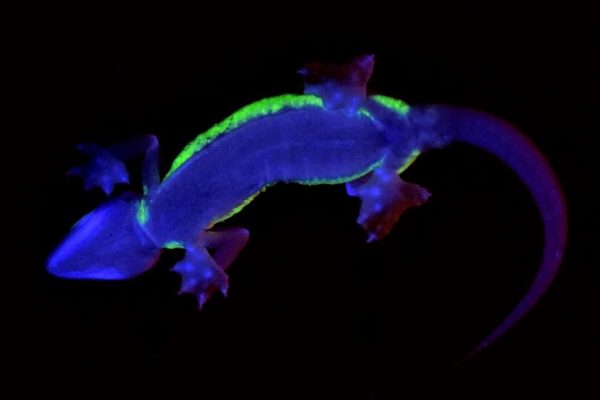Green Glowing Gecko Under UV-Light – Discovery of a New Mechanism for Fluorescence in a Terrestrial Vertebrate
Bavarian State Collection of Zoology
Researchers at the Bavarian State Collection of Zoology (SNSB-ZSM), the Ludwig-Maximilians University and Hochschule München have discovered that the web-footed gecko Pachydactylus rangei from Namibia fluoresces neon-green under UV light in a stripe along its flank and around its eye. These markings, best visible from the perspective of a gecko, presumably serve as a means to recognise geckos in the barren Namib desert the gecko calls home. In a multidisciplinary study, the researchers showed that this fluorescence is produced by iridophores (pigment cells filled with guanine crystals). The mechanism, as well as the brightness of the fluorescence, are unique and unprecedented among terrestrial vertebrates. The study was published today in the journal Scientific Reports.

Biofluorescence is known from many aquatic organisms, but has recently been increasingly discovered in terrestrial vertebrates as well. So far, two fluorescence mechanisms have been described from reptiles and amphibians: bone-based fluorescence (all bone is naturally fluorescent under UV light), and fluorescence of a chemical in secreted and circulated in lymph fluid. “As soon as we discovered this fluorescence, we realised that the web-footed geckos must use a new mechanism: the bright, neon-green fluorescence patterns were clearly produced in the skin of the lizards”, explains Dr David Prötzel, first author on the study.
Histological study of the web-footed gecko Pachydactylus rangei revealed, that the fluorescent areas of the skin are full of special pigment cells, iridophores, which are absent in the non-fluorescent areas of the skin. Iridophores reflect light, and play an important role in the colouration of geckos and other lizards. For the first time, this study revealed that some iridophores can also fluoresce. “This effect is much stronger than the bone-based fluorescence that we discovered in chameleons three years ago and one of the brightest known cases of fluorescence ever found in terrestrial vertebrates,” says Dr Frank Glaw, curator of Reptiles and Amphibians at the Bavarian State Collection of Zoology.
The moon is the only source of light during the nightly forages of these geckos in the deserts of Namibia. The blue component of the moonlight is absorbed by the geckos’ skin and emitted again as a brighter-looking, neon-green light. As though someone has taken a highlighter to these flanks, these geckos have a brightly visible signalling stripe.
The moon is the only source of light during the nightly forages of these geckos in the deserts of Namibia. The blue component of the moonlight is absorbed by the geckos’ skin and emitted again as a brighter-looking, neon-green light. As though someone has taken a highlighter to these flanks, these geckos have a brightly visible signalling stripe.
Publication:
Prötzel, D., Heß, M., Schwager, M., Glaw, F. & Scherz, M.D. (2021). Neon-green fluorescence in the desert gecko Pachydactylus rangei caused by iridophores. Sci Rep 11, 297 www.nature.com/articles/s41598-020-79706-z
Contact:
Dr. Frank Glaw
Bavarian State Collection of Zoology (SNSB-ZSM)
Münchhausenstr. 21, 81247 Munich
Tel.: +49 (0)89/8107 114
E-Mail: glaw@snsb.de
Dr. David Prötzel
Tel.: +49 (0)176/63200513
E-Mail: david.proetzel@mail.de
Download high-resolution images
Watch the corresponding Youtube Video (Dr. David Prötzel)

